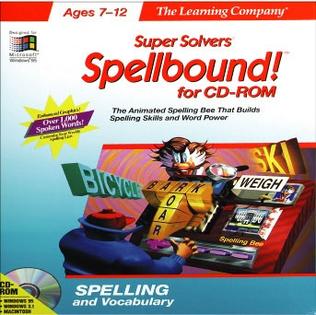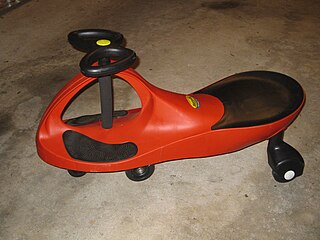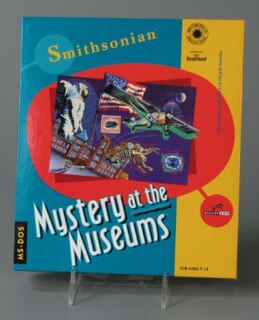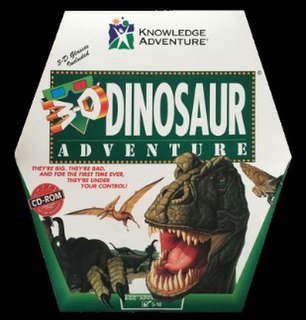Related Research Articles
The Blaster Learning System is an educational video game series originally created and published by Davidson & Associates, but is now owned and published by Knowledge Adventure, after the two companies were acquired and merged by CUC Software. Titles in the series have been produced for several computer systems, video game consoles, and as standalone handheld units. Originally, the series simply learned mathematics, but eventually expanded to other subjects, such as language arts (reading) and science. Due to the popularity of the original Math Blaster series, Davidson introduced Reading Blaster in 1994, which also went on to become successful.

Quarky & Quaysoo's Turbo Science is an educational computer game developed by Jeff Tunnell Productions and published by Sierra On-Line for MS-DOS in early 1992. It was designed to teach scientific concepts to children.

Kid Pix is a bitmap drawing program designed for children. Originally created by Craig Hickman, it was first released for the Macintosh in 1989 and subsequently published in 1991 by Broderbund. Hickman was inspired to create Kid Pix after watching his son Ben struggle with MacPaint, and thus the main idea behind its development was to create a drawing program that would be very simple to use.

Treasure MathStorm! is an educational computer game intended to teach children ages five to nine mathematical problem solving. This sequel to Treasure Mountain! is the sixth installment of The Learning Company's Super Seekers games and the second in its "Treasure" series.

The Playroom is a video game first created in 1989 for MS-DOS, Apple II and Macintosh computers. The game was compatible with the TouchWindow utility. It was ported to the Amiga and FM Towns computers in 1992 and 1994 respectively and then remade for Microsoft Windows and Macintosh in 1995. It was designed for ages 3 to 6 manufactured by Broderbund. A follow up game titled The Treehouse came in 1991 as well as a sequel to this game, called The Backyard in 1993.
I Spy is a children's book series with text written by Jean Marzollo, photographs by Walter Wick, and published by Scholastic Press. Each page contains a photo with objects in it, and the riddles accompanying the photo state which objects have to be found.

If You Give a Mouse a Cookie is a children's book written by Laura Numeroff and illustrated by Felicia Bond, first published in 1985 by Harper and Row. Described as a "circular tale", illustrating a slippery slope, it is Numeroff and Bond's first collaboration in what came to be the If You Give... series.

Spellbound! is an educational computer game made and distributed by The Learning Company aimed at teaching spelling, vocabulary, and language development to children ages 7 to 12 years. The objective of the game is to play spelling-related games to qualify and compete for successively higher bracket spelling bees, concluding with the player competing in the national spelling bee. The original game, released in 1991, was compatible with computers running DOS 3.3 or higher. A 1993 CD release added spoken dialogue and was compatible with Windows 95 and Macintosh.
McGee is a series of computer games released by Lawrence Productions for Kindergarteners ages 2–4.

Arthur's Teacher Trouble is a book in the Arthur series, released in 1986. It was written by Marc Brown and published by Little, Brown and Company and The Living Books Company.
KidDesk is an alternative desktop software application. The early childhood learning company Hatch Early Childhood created KidDesk; it subsequently went to Edmark, which was bought by IBM then sold to Riverdeep.

The Treehouse is an educational point-and-click personal computer game developed for DOS and then ported to Macintosh and the FM Towns, with Windows versions arriving later. Following the success of The Playroom, Broderbund created The Treehouse, which provides more content and furthers the user's ability to explore. First released in 1991, most copies were sold in educational supply stores rather than mainstream stores that sold computer software; it included a sing-along cassette tape. It was re-released in 1996 for Windows 3.1 and Windows 95. Although the Windows version has the same general activities, the characters, interface, and locations are different.

The PlasmaCar is a plastic ride-on toy car designed for children,, made popular by Canadian toy distributor PlaSmart. The PlasmaCar can be propelled by wiggling the front steering wheel which is attached to two pivoting wheels touching the ground. It harnesses the natural forces of inertia, centrifugal force, gravity, and friction in order to drive the car forward and backward. It does not require a power source such as batteries, fuel, pedals, or gears - it simply runs on the child's ability to wiggle the steering wheel. It can be operated indoors and/or outdoors, though it works best on a smooth, flat surface.

Mystery at the Museums is an educational video game developed by Binary Zoo Software and published by Artech Studios for MS-DOS in 1993. The game is Binary Zoo's second release as well as the second in their "Adventures With Edison" series.

Felicia Bond is an American writer and illustrator of numerous books for children. She is the illustrator of all the If You Give... series written by Laura Numeroff and published by HarperCollins Children's Books.
Lottie Dolls are a series of dolls created by Arklu Ltd. Launched in August 2012. Lottie promotes STEM subjects for kids and was even the first doll in space when she travelled to the International Space Station alongside British European Space Agency Astronaut, Tim Peake, on the Principia Mission, in December 2015.

3D Dinosaur Adventure is a 1993 educational interactive CD-ROM by Knowledge Adventure and released on DOS, Macintosh and Windows 3.x. The 1996 re-release was known as 3-D Dinosaur Adventure: Anniversary Edition.

Reader Rabbit's Ready for Letters is a 1992 video game and the fifth game of the Reader Rabbit franchise. Although a spin-off title, it is designed for ages 3 to 6 to teach prereaders about becoming literate and phonics.
References
- ↑ Carter, Reon. "Parents Can Consult Plenty Of 'Top Toys' Lists". The Cincinnati Enquirer via The Seattle Times . 2 December 1995.
- ↑ Kelati, Haben. "Top toys include Baby Yoda, unicorns, activity sets and puzzles". The Washington Post . 28 October 2020.
- ↑ Bonker, Dawn. "Travel Toys Smooth Way for Children". Sun-Sentinel . 28 July 1992.
- ↑ Rhoades, Heather. "Best Known Toy Awards". Streetdirectory.com . Retrieved 9 Jan 2021.
- ↑ Tousignant, Marylou. "Top new toys invite girls to build, boys to nurture and everyone to code". The Florida Times-Union . 3 November 2017.
- ↑ Staff. "Make Magic For The Kids With These Great Gifts". Today . 29 November 2004.
- ↑ Headapohl, Jackie. "Delicious Knishes In A New Children's Book". The Jewish News – Arts and Life . 7 December 2017.
- 1 2 3 Oppenheim, Joanne and Stephanie. The Best Toys, Books & Videos for Kids - "Introduction". HarperCollins. Pg.ix. 1993. ISBN 0062731963